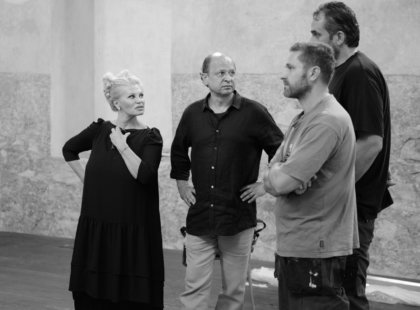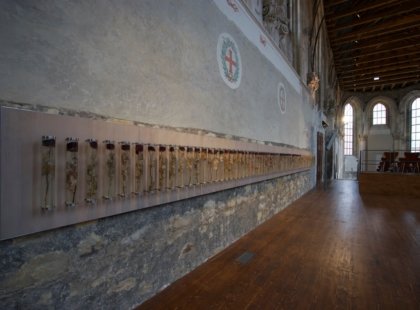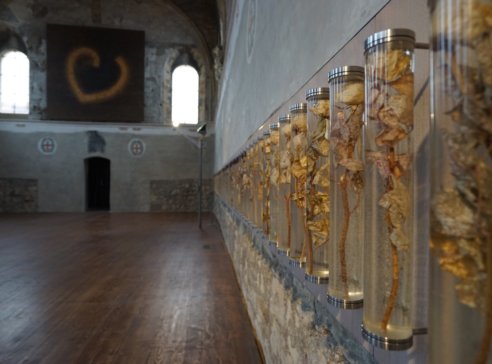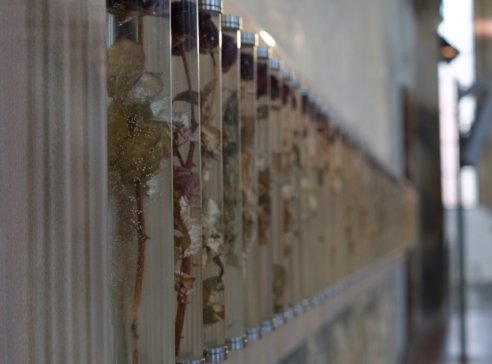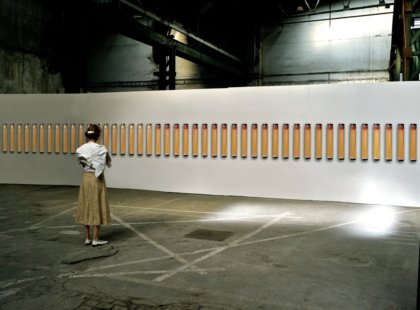Conceptual projects › Václav Havel’s Wheels of Time
The idea behind Václav Havel’s Wheels of Time came to me during the time when we were commemorating the death of the first president of the Czech Republic, Václav Havel, at the Prague Crossroads spiritual center on St. Anne’s Square in Prague’s Old Town.
The actual idea for the work was based on the random selection of several dozen roses that people had placed in Havel’s memory. The roses were then incorporated into a conceptual work of art honoring Havel’s legacy. The red and white roses were picked on 26 December 2011.
The staggering number of flowers placed in Havel’s memory were subsequently placed on a boat and taken down the Vltava, where they were tossed into the flowing waters of the river.
I chose to encase the flower stalks in transparent resin – it is durable, solid, and resistant to physical damage, but also visually clean and makes a very tactile impression. I know from personal experience that viewers like to touch it. In terms of form, the work was designed as a geometrically precise row of 75 cylindrical resin prayer wheels installed on kinetic bearings.
A central role in the design was played by my desire for the project to not feel static, for there to be physical interaction between the artwork and the viewer. This gives it a playful yet meditative subtext; the observer becomes a part of it.
I am sure that the non-conformist Václav Havel would have liked the idea.
I not only admired Václav Havel, but also had the good fortune to meet him in person and to “peripherally” observe his specific aesthetic style, which I have tried to incorporate in my work. Above all, these memories gave me the courage to even consider such a project.
The project is entitled Václav Havel’s Wheels of Time and works with the symbolic number 75 – the number of years that Václav Havel was alive. This is how many roses I decided to work with. One anonymous flower for each year of his life. Another important milestone besides the years of his birth (1936) and death (2011) was the revolutionary year 1989. This numbers game then inspired the idea of using 53 red flowers of suffering to express the number of years that Václav Havel spent living in an unfree country before the Velvet Revolution, and 22 white flowers of hope to symbolize his life after the revolution.
But the most important idea behind the work is Havel’s untiring struggle for freedom, that highest principle of human existence, which was expressed by his support for an independent Tibet and his open friendship with Tibet’s spiritual leader, the Dalai Lama.
This connection led me to the idea of Tibetan prayer wheels that viewers can spin just like Tibetan monks at a monastery, thus symbolically adding their life-giving energy to Havel’s legacy and to the flowers sealed away inside.
The title of the work is far from random as well. It is a clear paraphrase of the old proverb: “The wheels of time move slowly, but surely.”
My team and I spent five years working on the project. It was installed at Prague Crossroads in September 2016 in commemoration of what would have been Havel’s 80th birthday.
And so the roses returned to their place of origin in eternal memory of our president.
I would like to thank Mrs. Dagmar Havlová for her helpfulness, Mr. Martin Janda for his architectural and technical support, Mr. Albert Králiček for helping to cast the flowers in resin, as well as Mr. Vítězslav Tomosz and all the anonymous people who donated their roses.
Daniel Pešta
